Blueberries
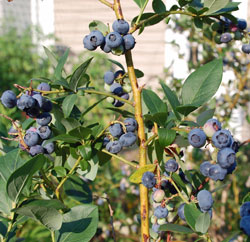 ©Janet Allen
©Janet Allen Blueberries
We have had wonderful success with blueberries for the past several years with the plants we put in five or six years ago. (I think the particular cultivars we planted were Bluecrop, Blueray, and Jersey.)
In 2009 we picked about 23 pounds of blueberries from our six plants. Blueberries need pretty acidic soil, preferably with a pH between 4.0 and 5.0, and the pH of our garden soil was 7.2 when we tested it this past year. I have read that it is very difficult to amend soil that is actually alkaline as ours is. So the question is why have our blueberries done so well?
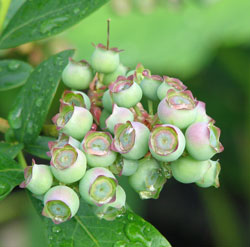 ©Janet Allen
©Janet Allen Blueberries before ripening
I thought the answer was that we were adding sulfur to acidify the soil. And adding oak leaves and pine needles as mulch. I added sulfur by scattering it on the surface around the blueberry plants, assuming that the rain and watering would work it into the soil. I recently read that you actually have to dig the sulfur into the soil.
Obviously I need a pH test kit so that I can actually see what it is in the blueberry area.
Production in 2010 was noticeably less than the previous two years but I thought that might have been because the birds (especially catbirds) took a liking to the blueberries. When I look at the figures for last year I see that we picked only 10 ¾ pounds, so that is a lot less than the year before. I also noticed that there was very little new growth on the plants. If so, that means that this year's crop will be even smaller.
None of this answers the question of why the blueberries did so well for those first few years. The only answer that comes to mind is that maybe I mixed sulfur into the soil when I planted them and that kept the soil acidic enough for a couple of years for the plants to bear a lot of fruit.
When spring comes I will be digging sulfur into the soil around the blueberries (and testing the soil for pH) in the hopes that over the next several years I will lower the pH enough for the plants to thrive once again.
Blueberries: The birds and the bees
We didn't have very much trouble at all with birds for many years. We started getting some bird damage, though, so we created this cage.
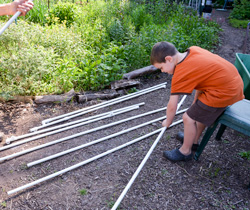 ©Janet Allen
©Janet Allen Helping Grandpa assemble the cage
We reassemble the cage each year. It's just PVC pipes and the connectors.
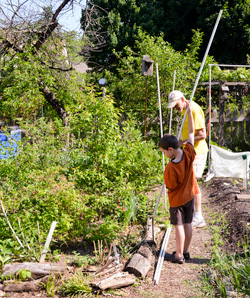 ©Janet Allen
©Janet Allen Assembling the frame
The rebar is permanent, so all we have to do is place the PVC pipes over the rebar. (We keep a short white PVC pipe covering the rebar the rest of the year.)
Then we attach the bird netting to the frame. We make sure that it's fastened all around.
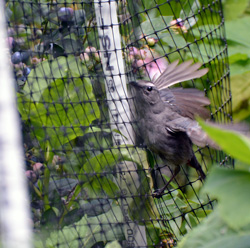 ©Janet Allen
©Janet Allen Catbird eyeing the berries
The catbird is looking longingly from the "ceiling" of the cage, but he can't get in. We've securely fastened it to the soil at the bottom using tent stakes, and we clip the "door" shut with clothespins.
We still keep an eye on it in case birds get in somehow, but so far no bird has gotten in that can't get out.
(And we don't feel too sorry for the catbirds. We have pagoda dogwood berries aplenty ripening along with the blueberries.)
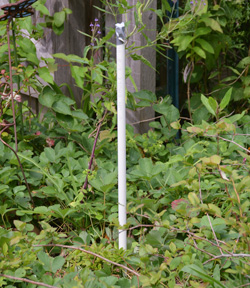 ©Janet Allen
©Janet Allen Post bottom
At the end of the blueberry season, we remove the nets and the tall posts. We leave the bottom of the corner posts in place all year. They're about three feet high, and we cover the hole with duct tape.
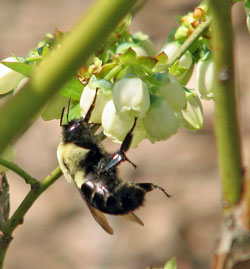 ©Janet Allen
©Janet Allen Blueberries being pollinated by a bee
We wouldn't have any blueberries at all without the help of our bees! Here's one of our bumblebees at work. We try to make our yard as bee-friendly as possible. (In the photo of the bird cage above, the wooden nests are for cavity-nesting native solitary bees of all types.)
Blueberries are a beautiful landscaping plant
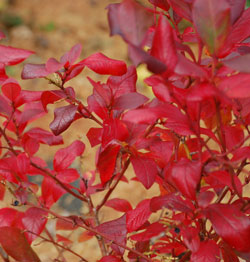 ©Janet Allen
©Janet Allen Blueberries in fall
Blueberries can serve double-duty as a native edible landscaping plant. The fall color beats any of the garish non-native burning bushes.
Harvest record
| YR | LB | Notes |
| 15 | ||
| 14 | 24 | |
| 13 | 24 | We freeze them all for smoothies during the year |
| 12 | 8 | |
| 11 | 15 | |
| 10 | 11 | |
| 09 | 23 |

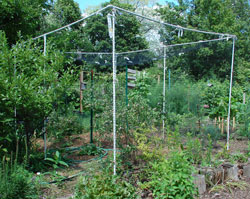 (Enlarge)
(Enlarge)